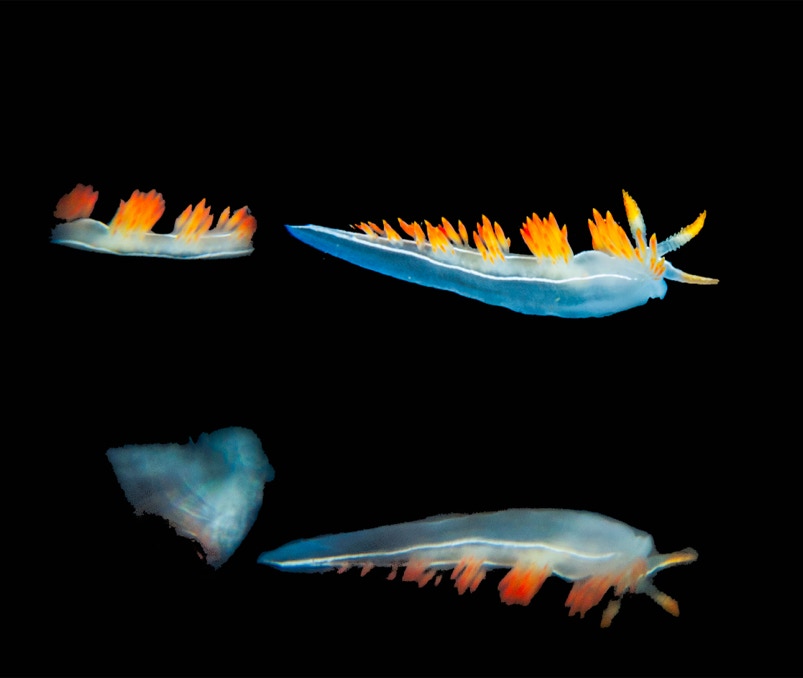
A couple of weeks ago we went diving with friends on the Giant Stride. Mostly we have been doing blue/green water dives looking for jellies, but we did a reef dive at Garden Spot. Here is a nice little Orienthella trilineata (used to be a Flabellina) sitting on the telescope felt stage. These species are one of the few nudibranch species that are known to be aposematic (a new word for me) meaning that they are brightly colored so that they don't get eaten. There is discussion in the literature (Rosenberg, Evolution, 1988, p.1811) about how this can come about with no good answer. In insects it typically is known to be due to kin selection, i.e. if you live in a group it is to the group's advantage if you all look poisonous. In nudibranchs that have a pelagic stage this can not be the driving force. Individual selection would thus appear to be the driving force in the evolution of protective coloring.

Saturday we went diving with friends on the Giant Stride. We did 2 bluewater (OK it was green) dives and a reef dive. Conditions were meh with lots of crud in the water but if you got down deep enough (100 ft or so) there was a lake of pyrosomes. Pyrosomes are free floating colonial tunicates. They range from tiny to ginormous (they can get up to many meters long). This one was about 8 cm or a bit more than 3 inches for those metrically challenged. They are named pyrosomes because they have spectacular bioluminescence. For many years no one knew how they generated light but recently looking at the lifetime of their bioluminescence (in a lab) it is pretty clear that the light has to be made by symbiotic bacteria. For details see Leisman G, Cohn DH, Nealson KH. Bacterial origin of luminescence in marine animals. Science. 1980 Jun 13;208(4449):1271-3. doi: 10.1126/science.208.4449.1271. PMID: 17830813.

Here is a nice little fried egg jellyfish, Phacellophora camtschatica that we saw on a recent blue water dive with friends on the Giant Stride. It is an interesting creature, its body has no respiratory, circulatory or excretory systems but rather it uses its large surface area to accomplish those functions. It can live in very low oxygen environments by storing oxygen in the gel that makes up much of the bell. In very low oxygen environments, the gel can supply more than 80% of the animal's oxygen needs for up to 48 hours (if I did the math right).

Here is a nice little sea angel/butterfly from last week's blue/green water dive.

We went diving last weekend with friends on the Giant Stride. One blue/greenwater dive and two reefs. The vis was not great but there were lots of nudibranchs around. Here is a nice little Triopha catalinea sitting on the telescope felt stage, from Hawthorne reef.

Here is a nice little A. lutea sitting on the telescope felt stage. We were diving with friends on the Giant Stride two weeks ago and this guy showed up. Acanthodoris can make very complex chemicals that are extraordinarily difficult to make in the lab; nudibranchs and their food are very sophisticated in terms of making new compounds.

Here is a nice little Corynactis shot up into the black from a recent dive on the Giant Stride with friends. Corynactis come in a wide variety of colors, many of which are due to the exact same astaxanthins that make Spanish Shawls so colorful. Corynactis are mean and aggressive. If you put a Corynactis next to say a Metridium, the Corynactis will send out tentacles from her mouth and kill the Metridium.

We went diving yesterday on the Giant Stride to celebrate birthdays (Nannette today, Dana and Ana next week). On Biodome we (not me) found this nice little Hopkins Rose, here sitting on the dichroic glass stage.

Here is Mrs. Rose sitting on top of the reef.

Went diving a week ago with friends on the Giant Stride. I took along a version of the square fun-house tube of reflections. Here is one of our ubiquitous black eye gobies looking at himself.

Another shot with the square tube. This one a local tiny cup coral.

Enjoy a common nudibranch shot through the fun house square reflector.

On our last reef dives, I didn't only shoot with the square tubes. Here is a nice little Hopkins Rose (Okenia rosacea) here sitting on the telescope felt stage and having a bad hair day.

We went to Catalina a couple of weeks ago with friends and did a couple of dives at the Marine Park. For some it was to see the Giant Sea Bass, for me the highlight was the Largemouth Blenny. This is a relatively new fish for SoCal, Milt Love says it was first observed in California waters only 6 years ago (Bull So Cal Acad Sciences, 2016, p 191).













